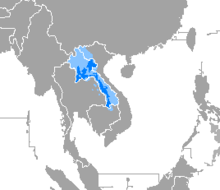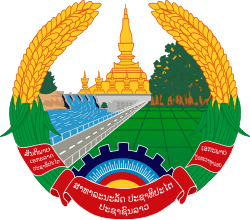Lao language
| Lao | |
|---|---|
| ພາສາລາວ phasa lao | |
 | |
| Pronunciation | pʰáːsǎː láːw |
| Native to | Laos, northeastern Thailand |
Native speakers |
20–25 million (2004)[1] (3 million in Laos, 2005 census)[2] |
|
Tai–Kadai
| |
|
Lao in Laos Thai in Thailand Thai and Lao Braille | |
| Official status | |
Official language in |
|
| Language codes | |
| ISO 639-1 |
lo |
| ISO 639-2 |
lao |
| ISO 639-3 |
Either: lao – Laotian Lao tts – Isan (Thailand Lao) |
| Glottolog |
laoo1244 (Lao)[3]nort2741 (Northeastern Thai)[4] |
| Linguasphere |
47-AAA-c |
 | |
Lao, also referred to as Laotian, (ລາວ 'lao' or ພາສາລາວ 'lao language') is a tonal language of the Tai–Kadai language family. It is the official language of Laos, and also spoken in the northeast of Thailand, where it is usually referred to as the Isan language.
The Lao language serves as an important lingua franca as the country of Laos consists of multiple ethnic groups, whose population speaks about 86 different languages.[5]
Spoken Lao is mutually intelligible with the Thai language (the two languages are written with slightly different scripts but are linguistically similar).
Lao, like many languages in Laos, is written in the Lao script, an abugida. Although there is no official standard, the Vientiane dialect has become the de facto standard.
History
The Lao language is descended from Tai languages spoken in what is now southern China and northern Vietnam in areas believed to be the homeland of the language family and where several related languages are still spoken by scattered minority groups.
Due to Han Chinese expansion, Mongol invasion pressures, and a search for lands more suitable for wet-rice cultivation, the Tai peoples moved south towards India, down the Mekong River valley, and as far south as the Malay Peninsula. Oral history of the migrations is preserved in the legends of Khun Borom. Tai speakers in what is now Laos pushed out or absorbed earlier groups of Mon–Khmer and Austronesian languages.
Dialects
| Dialect | Lao Provinces | Thai Provinces |
| Vientiane Lao | Vientiane, Vientiane Capital Prefecture, Bolikhamsai | Nong Bua Lamphu, Chaiyaphum, and parts of Nong Khai, Yasothorn, Khon Kaen, and Udon Thani. |
| Northern Lao | Luang Prabang, Sainyabuli, Oudomxay. | Loei and parts of Udon Thani and Khon Kaen.[6] |
| Northeastern Lao/Tai Phuan | Xiangkhoang and Houaphanh. | Parts of Sakon Nakhon, Udon Thani.[7] |
| Central Lao | Savannakhet and Khammouan. | Mukdahan and parts of Sakon Nakhon and Nong Khai. |
| Southern Lao | Champasak, Salavan, Sekong, and Attapeu. | Ubon Ratchathani, Amnat Charoen, and parts of Yasothorn, Buriram, Si Sa Ket, Surin and Nakhon Ratchasima[8] |
| Western Lao | [9] | Kalasin, Maha Sarakham, and Roi Et. |
In addition to the dialects of Lao, numerous closely related languages (or dialects, depending on the classification) are spoken throughout the Lao-speaking realm in Laos and Thailand, such as the Nyaw, Phu Thai, Saek, Lao Wiang, Tai Dam, Tai Daeng, etc. These Tai peoples are classified by the Lao government as Lao Loum (ລາວລຸ່ມ) or lowland Lao. Lao and Thai are also very similar and share most of their basic vocabulary, but differences in many basic words limit inter-comprehension.
Vocabulary
The Lao language consists primarily of native Lao words. Because of Buddhism, however, Pali has contributed numerous terms, especially relating to religion and in conversation with members of the Sangha. Due to their geographic proximity, Lao has influenced the Khmer and Thai languages and vice versa.
Formal writing has a larger amount of foreign loanwords, especially Pali and Sanskrit terms, much as Latin and Greek have influenced European languages. For politeness, pronouns (and more formal pronouns) are used, plus ending statements with ແດ່ (dè [dɛː]) or ເດີ້ (deu [dɤ̂ː]). Negative statements are made more polite by ending with ດອກ (dok [dɔ̭ːk]). The following are formal register examples.
- ຂອບໃຈຫຼາຍໆເດີ້ (khop chai lai lai deu, [kʰɔ᷆ːp t͡ɕàj lǎːj lǎːj dɤ̂ː]) Thank you very much.
- ຂ້ານ້ອຍເຮັດບໍ່ໄດ້ດອກ (khanoi hét bo dai dok, [kʰa᷆ːnɔ̂ːj hēt bɔ̄ː dâj dɔ᷆ːk]) I cannot.
- ໄຂປະຕູໃຫ້ແດ່ (khai pa too hai dè, [kʰǎj pa.tùː ha᷆j dɛ̄ː ]) Open the door, please.
Phonology
Consonants
Many consonants in Lao make a phonemic contrast between labialized and plain versions. The complete inventory of Lao consonants is as shown in the table below:[10]
Initial consonants
| Labial | Alveolar | Palatal | Velar | Glottal | ||||||
|---|---|---|---|---|---|---|---|---|---|---|
| plain | lab. | plain | lab. | plain | lab. | plain | lab. | |||
| Plosive | voiced | b | d | |||||||
| voiceless | p | t | tɕ | tɕʷ | k | kʷ | ʔ | ʔʷ | ||
| aspirated | pʰ | tʰ | tʷʰ | kʰ | kʷʰ | |||||
| Fricative | f | s | sʷ | h | ||||||
| Nasal | m | n | ɲ | ŋ | ŋʷ | |||||
| Approximant | l | lʷ | j | w | ||||||
Final consonants
All plosive sounds are unreleased in final position. Hence, final /p/, /t/, and /k/ sounds are pronounced as [p̚], [t̚], and [k̚] respectively.
| Bilabial | Labio- dental |
Alveolar | Palatal | Velar | Glottal | |
|---|---|---|---|---|---|---|
| Nasal | m | n | ŋ | |||
| Plosive | p | t | k | ʔ* | ||
| Approximant | w | j | ||||
- * The glottal stop appears at the end when no final follows a short vowel.
Vowels
All vowels (including diphthongs) make a phonemic length distinction. The vowels are as shown in the following table:[10]
|
| ||||||||||||||||||||||||||||||
Diphthongs are all centering diphthongs with falling sonority:[10]
| Closer component is front |
Closer component is back unrounded |
Closer component is back rounded | |
|---|---|---|---|
| Short diphthongs | iə̯ | ɯə̯ | uə̯ |
| Long diphthongs | iːə̯ | ɯːə̯ | uːə̯ |
Tones
Lao has six lexical tones.[11]
Unchecked syllables
There are six phonemic tones in unchecked syllables, that is, in syllables ending in a vowel or other sonorant sound ([m], [n], [ŋ], [w], and [j]).
| Name | Diacritic on ⟨e⟩ | Tone letter | Example | Gloss |
|---|---|---|---|---|
| Rising | ě | ˨˦ or ˨˩˦ | /kʰǎː/ ຂາ |
leg |
| High level | é | ˦ | /kʰáː/ ຄາ |
stuck |
| High falling | ê | ˥˧ | /kʰâː/ ຄ້າ |
trade |
| Mid level | ē | ˧ | /kʰāː/ ຂ່າ, ຄ່າ |
galangal, value resp. |
| Low level | è | é | /kàː/ ກາ |
crow |
| Low falling | e᷆ | ˧˩ | /kʰa᷆ː/ ຂ້າ |
kill, servant |
Checked syllables
The number of contrastive tones is reduced to four in checked syllables, that is, in syllables ending in an obstruent sound ([p], [t], [k], or the glottal stop [ʔ]).
| Tone | Example | Gloss |
|---|---|---|
| high | /hák/ ຫັກ | break |
| mid | /hāk/ ຮັກ | love |
| low-falling | /ha᷆ːk/ ຫາກ | if, inevitably |
| falling | /hâːk/ ຮາກ | vomit, root |
Syllables
Lao syllables are of the form (C)V(C), i.e. they consist of a vowel in the syllable nucleus, optionally preceded by a single consonant in the syllable onset and optionally followed by single consonant in the syllable coda. The only consonant clusters allowed are syllable initial clusters /kw/ or /kʰw/. Any consonant may appear in the onset, but the labialized consonants do not occur before rounded vowels.[10]
Only /p t k ʔ m n ŋ w j/ may appear in the coda. If the vowel in the nucleus is short, it must be followed by a consonant in the coda; /ʔ/ in the coda can be preceded only by a short vowel. Open syllables (i.e. those with no coda consonant) and syllables ending in one of the sonorants /m n ŋ w j/ take one of the six tones, syllables ending in /p t k/ take one of four tones, and syllables ending in /ʔ/ take one of only two tones.[10]
Morphology
The majority of Lao words are monosyllabic, and are not inflected to reflect declension or verbal tense, making Lao an analytic language. Special particle words serve the purpose of prepositions and verb tenses in lieu of conjugations and declensions. Lao is a subject–verb–object (SVO) language, although the subject is often dropped. In contrast to Thai, Lao uses pronouns more frequently.
Script
The Lao religious script is written in the Tua Tham script, based on Mon scripts[12] and still used in temples in Laos and Isan. The Lao script (Tua Lao), derived locally around the 14th century from the Khmer script of Angkor,[13] is ultimately rooted in the Brahmic script of India.[12] Although similar to one another, the Lao alphabet is more phonetic than the Thai alphabet due to various Lao royal decrees concerning orthographic reforms, resulting in the Lao script having fewer duplicate sounds thus making the Lao script more phonetic, efficient and easy to learn.
Words are spelt according to phonetic principles as opposed to etymological principles. In addition to consonants having tone classes, tone marks facilitate marking tones where they are needed. Romanisation of Lao is inconsistent, but is based on French transcriptive methods.
Numerals may be written out as words (1 vs. one), but numerical symbols are more common. Although Arabic numerals are most common, Lao numerals, from the Brahmi script are also taught and employed.
Punctuation
Lao is traditionally not written with spaces between words, although signs of change are multiplying. Spaces are reserved for ends of clauses or sentences. Periods are not used, and questions can be determined by question words in a sentence. Traditional punctuation marks include ໌, an obsolete mark indicating silenced consonants; ໆ, used to indicate repetition of the preceding word; ຯ, the Lao ellipsis that is also used to indicate omission of words; ฯ, a more or less obsolete symbol indicating shortened form of a phrase (such as royal names); and ฯລฯ, used to indicate et cetera.
In more contemporary writing, punctuation marks are borrowed from French, such as exclamation point !, question mark ?, parentheses (), and «» for quotation marks, although "" is also common. Hyphens (-) and the ellipsis (...) are also commonly found in modern writing.
Indication of tones
Experts disagree on the number and nature of tones in the various dialects of Lao. According to some, most dialects of Lao and Isan have six tones, those of Luang Prabang have five. Tones are determined as follows:
| Tones | Long vowel, or vowel plus voiced consonant | Long vowel plus unvoiced consonant | Short vowel, or short vowel plus unvoiced consonant | Mai ek (ອ່) | Mai tho (ອ້) |
|---|---|---|---|---|---|
| High consonants | rising | low falling | high | mid | low falling |
| Mid consonants | low rising | low falling | high | mid | high falling |
| Low consonants | high | high falling | mid | mid | high falling |
A silent ຫ (/h/) placed before certain consonants will produce place the other proceeding consonant in the high class. This can occur before the letters ງ /ŋ/, ຍ /ɲ/, ຣ /r/, and ວ /v/ and combined in special ligatures (considered separate letters) such as ຫຼ /l/, ໜ /n/, and ໝ /m/. In addition to ອ່ (low tone) and ອ້ (falling tone), there also exists the rare ອ໊ (high) ອ໋ (rising) tone marks.
See also
References
- ↑ ca. 20M Isan, 3M Laotian
- ↑ Lao language at Ethnologue (18th ed., 2015)
- ↑ Hammarström, Harald; Forkel, Robert; Haspelmath, Martin; Bank, Sebastian, eds. (2016). "Lao". Glottolog 2.7. Jena: Max Planck Institute for the Science of Human History.
- ↑ Hammarström, Harald; Forkel, Robert; Haspelmath, Martin; Bank, Sebastian, eds. (2016). "Northeastern Thai". Glottolog 2.7. Jena: Max Planck Institute for the Science of Human History.
- ↑ "Lao | About World Languages". aboutworldlanguages.com. Retrieved 2016-05-25.
- ↑ Northern Lao is also spoken in large parts of Uttaradit Province and Phitsanulok, which are outside the Isan region.
- ↑ Northeastern Lao is sometimes considered a separate language, as it is traditionally spoken by Phuan tribal members, a closely related but distinct Tai group. Also spoken in a few small and scattered Tai Phuan villages in Sukhothai, Uttaradit, and Phrae.
- ↑ Southern Loa gives way to Northern Khmer in Si Sa Ket, Surin, and Buriram, and to Khorat Thai and, to some extant, Northern Khmer in Nakhon Ratchasima.
- ↑ The Western Lao dialect is not spoken in Laos.
เรืองเดช ปันเขื่อนขัติย์. (2531) - 1 2 3 4 5 Blaine Erickson, 2001. "On the Origins of Labialized Consonants in Lao". Analysis based on L. N. Morev, A. A. Moskalyov and Y. Y. Plam, (1979). The Lao Language. Moscow: USSR Academy of Sciences, Institute of Oriental Studies. Accessed 2009-12-19.
- ↑ Blaine Erickson, 2001. "On the Origins of Labialized Consonants in Lao". Analysis based on T. Hoshino and R. Marcus (1981). Lao for Beginners: An Introduction to the Spoken and Written Language of Laos. Rutland/Tokyo: Tuttle. Accessed 2009-12-19.
- 1 2 UCLA International Institute, (n.d.). "Lao". Accessed 2010-07-27.
- ↑ Benedict, Paul K. "Languages and literatures of Indochina." The Far Eastern Quarterly (1947): 379-389.
Further reading
- Lew, Sigrid. 2013. "A linguistic analysis of the Lao writing system and its suitability for minority language orthographies".
- ANSI Z39.35-1979, System for the Romanization of Lao, Khmer, and Pali, ISBN 0-88738-968-6.
- Hoshino, Tatsuo and Marcus, Russel. (1989). Lao for Beginners: An Introduction to the Spoken and Written Language of Laos. Tuttle Publishing. ISBN 0-8048-1629-8.
- Enfield, N. J. (2007). A Grammar of Lao. Berlin and New York: Mouton de Gruyter. ISBN 3-11-018588-1.
- Cummings, Joe. (2002). Lao Phrasebook: A Language Survival Kit. Lonely Planet. ISBN 1-74059-168-2.
- Mollerup, Asger. Thai–Isan–Lao Phrasebook. White Lotus, Bangkok, 2001. ISBN 974-7534-88-6.
- Kerr, Allen. (1994). Lao–English Dictionary. White Lotus. ISBN 974-8495-69-8.
- Simmala, Buasawan and Benjawan Poomsan Becker (2003), Lao for Beginners. Paiboon Publishing. ISBN 1-887521-28-3
External links
| Lao edition of Wikipedia, the free encyclopedia |
| Wikivoyage has a phrasebook for Lao. |
| Wikimedia Commons has media related to Lao language. |
- Lao Language & Culture Site
- Google Translate
- http://www.stars21.com/translator/english_to_lao.html
- http://www.laosoftware.com/index.php
- http://unicode-table.com/en/sections/lao/
- Omniglot: Lao script
- JUSK Lao, a javascript based Lao unicode keyboard
- Laoconnection.com
- AbcdLaos Lao Language in Spanish
- USA Foreign Service Institute Lao basic course
- http://asiansouls.com/laofonts/
